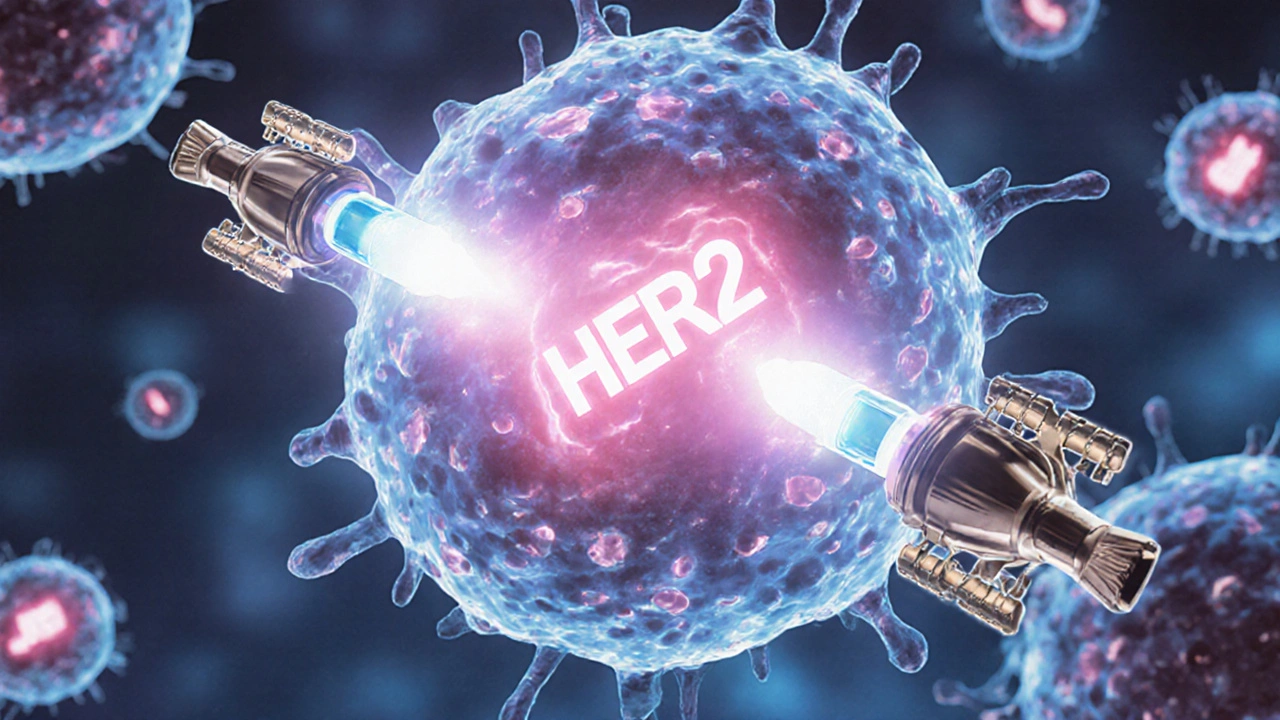What is HER2-positive breast cancer?
HER2-positive breast cancer is a specific type of breast cancer where tumor cells make too much of a protein called HER2. This protein acts like a switch that tells cells to grow and divide. When it’s overactive, cancer grows fast and spreads more easily. About 1 in 5 people diagnosed with breast cancer - roughly 15% to 20% - have this subtype. It used to be one of the most aggressive forms, but today, it’s one of the most treatable thanks to targeted therapies designed specifically for HER2.
How do HER2-targeted therapies work?
Unlike traditional chemotherapy, which attacks all fast-growing cells, HER2-targeted therapies lock onto the HER2 protein like a key in a lock. They block the signals that tell cancer cells to multiply. Some drugs also carry toxic chemicals directly to the cancer cells, killing them from the inside while sparing healthy tissue. This precision means fewer side effects like hair loss or severe nausea - but they come with their own unique risks, like heart problems or lung inflammation.
The main types of HER2-targeted drugs
There are four main classes of HER2-targeted drugs, each with different ways of working and different uses.
- Monoclonal antibodies - These are lab-made proteins that stick to HER2. Trastuzumab (Herceptin) was the first and is still the backbone of treatment. It’s given through IV or a quick under-the-skin shot. Newer versions like pertuzumab (Perjeta) block HER2 in a different spot, and when used together, they’re more powerful. Phesgo combines both into one subcutaneous injection that takes just 8 minutes - instead of hours of IV infusion.
- Antibody-drug conjugates (ADCs) - These are like smart missiles. They combine a HER2-targeting antibody with a powerful chemotherapy drug. T-DM1 (Kadcyla) delivers chemo directly to HER2 cells. But the real game-changer is trastuzumab deruxtecan (T-DXd, Enhertu). It carries more chemo per antibody and has shown dramatic results in late-stage disease, even when other treatments failed. In one trial, it cut the risk of cancer worsening by 72% compared to T-DM1.
- Tyrosine kinase inhibitors (TKIs) - These are pills that block HER2 from the inside of the cell. Lapatinib, neratinib, and tucatinib fall into this group. Tucatinib is especially important because it crosses the blood-brain barrier, making it one of the few drugs that can effectively treat HER2-positive breast cancer that has spread to the brain. In trials, adding tucatinib to trastuzumab and capecitabine boosted survival by over 4 months compared to the older combo.
- Newer monoclonal antibodies - Margetuximab (Margenza) is designed to help the immune system better attack HER2 cells. It’s used after at least two other HER2 drugs have stopped working.
How are these drugs used in treatment?
When you’re first diagnosed, your treatment plan depends on whether the cancer is still in the breast or has spread.
- Early-stage cancer - If the tumor is larger than 2 cm, doctors often start with neoadjuvant therapy: trastuzumab plus pertuzumab and chemotherapy before surgery. This can shrink the tumor so much that less invasive surgery is needed. After surgery, you’ll usually continue trastuzumab for a full year.
- Metastatic cancer - When cancer has spread, treatment is ongoing. First-line therapy is usually trastuzumab, pertuzumab, and a taxane chemo drug. If that stops working, T-DM1 is next. If T-DM1 fails, T-DXd becomes the standard. For patients with brain metastases, tucatinib-based regimens are now preferred. Some people also get margetuximab if they’ve tried at least two other HER2 drugs.

What are the side effects - and how are they managed?
These drugs are powerful, but they’re not without risks.
- Heart problems - Trastuzumab and pertuzumab can weaken the heart muscle. About 2% to 7% of patients develop heart failure. That’s why doctors check your heart function with an echocardiogram before treatment and every 3 months while you’re on it. If your heart weakens, treatment may pause or change.
- Interstitial lung disease (ILD) - T-DXd carries a serious warning for this. About 10% to 15% of patients get inflammation in the lungs, which can cause a dry cough or shortness of breath. It’s rare but can be life-threatening. If you develop new breathing issues, tell your doctor right away - stopping the drug early often reverses it.
- Diarrhea - Neratinib and some TKIs cause severe diarrhea in many patients. Prophylactic loperamide (Imodium) is often prescribed from day one. One patient on a support forum said they had to stop neratinib after two months because the diarrhea was unbearable.
- Low platelets and liver issues - T-DM1 can lower platelet counts and raise liver enzymes. Regular blood tests catch this early.
Many patients report that HER2-targeted therapies are easier to tolerate than chemo. No more vomiting or losing hair. But the new side effects - heart checks, lung scares, constant diarrhea - bring their own kind of stress.
What’s new in HER2 treatment?
The field is moving fast. In 2023, the definition of HER2-positive changed. Now, there’s also HER2-low - a group that includes about half of all breast cancers. These tumors don’t overexpress HER2, but they have a little bit. T-DXd is now approved for HER2-low metastatic breast cancer too, based on the DESTINY-Breast04 trial. That’s a huge shift - it means far more people can benefit from this drug.
Next up? HER2-ultralow (IHC 0) is being tested in the DESTINY-Breast06 trial. If successful, nearly 70% of all breast cancer patients could be eligible for T-DXd. Bispecific antibodies like Zanidatamab are in phase 3 trials, targeting two HER proteins at once. And researchers are testing T-DXd with immunotherapy drugs like pembrolizumab to see if combining them works even better.
There’s also growing focus on brain metastases. Tucatinib’s success changed the game. Now, new TKIs are being designed to cross the blood-brain barrier even more effectively. Cardiac-sparing HER2 drugs are also in development, aiming to keep the heart safe while still killing cancer.
Cost and access
These drugs are expensive. T-DXd costs about $17,000 per month in the U.S. Even with insurance, out-of-pocket costs can be high. Biosimilars of trastuzumab have brought prices down, but newer drugs like T-DXd and tucatinib still carry high price tags. Access varies by country and insurance. In places like New Zealand, public funding often covers these drugs, but wait times or strict eligibility rules can delay treatment.

What does the future look like?
HER2-positive breast cancer is no longer a death sentence. Ten years ago, metastatic HER2-positive cancer had a median survival of about 2 years. Today, many patients live 5, 7, even 10 years or more. The reason? Better drugs, smarter sequencing, and a deeper understanding of resistance.
But challenges remain. Some tumors stop responding. Others come back in the brain. Costs are rising. Not everyone gets access. Still, the progress is real. With over 150 active clinical trials exploring new combinations, ADCs, and smarter delivery systems, the next five years will likely bring even more breakthroughs.
What should you ask your doctor?
- Is my cancer HER2-positive, HER2-low, or HER2-ultralow? What test was used?
- What’s my treatment plan, and why this drug over another?
- What are the biggest risks for me - heart, lungs, or diarrhea?
- Will I need regular heart scans? How often?
- Are there clinical trials I might qualify for?
- How will this affect my daily life - work, travel, family time?
Is HER2-positive breast cancer curable?
In early stages, yes - many people are cured with surgery, chemotherapy, and a year of HER2-targeted therapy. For metastatic disease, it’s usually not curable, but it’s often manageable for many years. With newer drugs like T-DXd and tucatinib, survival has increased dramatically. Some patients live 7 to 10 years or longer with good quality of life.
Can HER2-targeted therapies cause heart damage?
Yes, especially trastuzumab and pertuzumab. About 2% to 7% of patients develop heart failure. That’s why heart function is checked before treatment and every 3 months. If your heart weakens, your doctor may pause treatment. In many cases, heart function improves after stopping the drug. Newer drugs like T-DXd and TKIs have lower heart risks, but monitoring is still standard.
Why is T-DXd considered a breakthrough?
T-DXd delivers more chemotherapy directly to cancer cells than older ADCs like T-DM1. In the DESTINY-Breast03 trial, it cut the risk of cancer worsening or death by 72% compared to T-DM1. It also works in HER2-low cancers - a group that previously didn’t qualify for HER2 drugs. Its effectiveness in brain metastases and after multiple prior treatments makes it one of the most powerful options today.
Do these drugs work for brain metastases?
Most HER2 drugs, like trastuzumab, don’t cross the blood-brain barrier well. But tucatinib (Tukysa) does - and it’s the first drug proven to extend survival in patients with HER2-positive brain metastases. In trials, adding tucatinib to trastuzumab and capecitabine improved survival by over 4 months. T-DXd also shows activity in the brain, making it another strong option for this difficult complication.
What’s the difference between HER2-positive and HER2-low?
HER2-positive means cancer cells have a lot of HER2 protein (IHC 3+ or IHC 2+ with FISH positive). HER2-low means they have a little bit - not enough to be called positive, but enough to respond to T-DXd. This group makes up about 50% to 60% of all breast cancers. The change in definition means far more people now qualify for T-DXd, which has reshaped treatment guidelines.
Next steps if you’re starting treatment
If you’ve just been diagnosed with HER2-positive breast cancer, start by asking your oncologist for a copy of your pathology report. Make sure it clearly states your HER2 status. Ask if you’re eligible for any clinical trials - many new drugs are only available that way. Keep a symptom journal: note any cough, shortness of breath, diarrhea, or swelling. Bring it to every appointment. Talk to your care team about heart health - ask if you need a cardiologist on your team. And don’t ignore support groups. Patients who’ve been through this know what to expect - and they can help you prepare.

